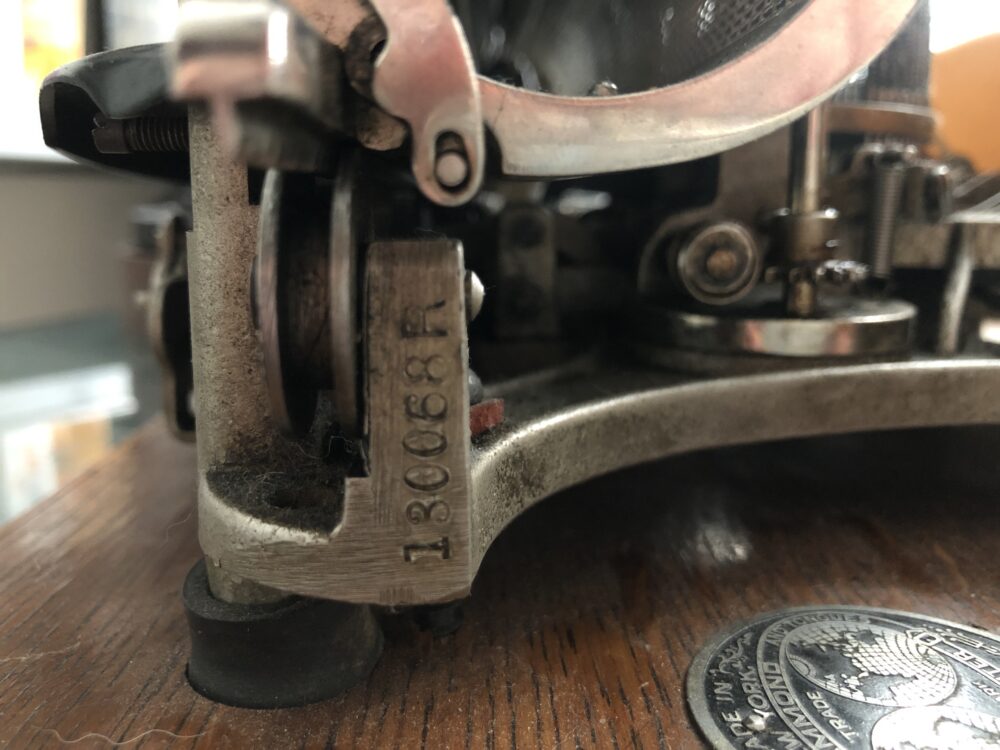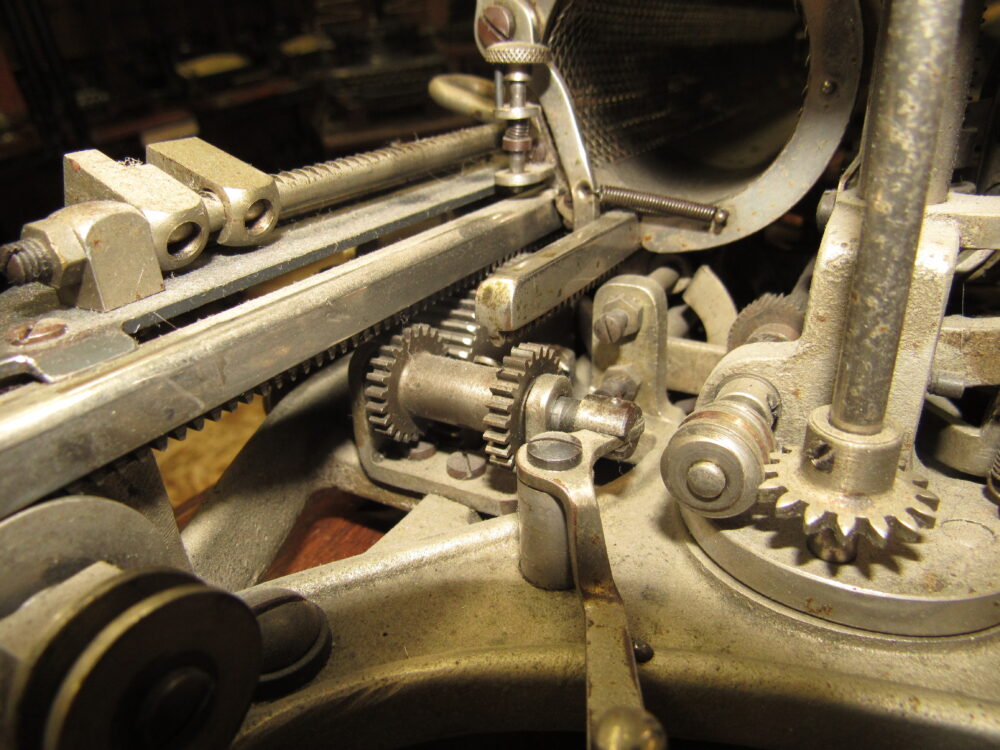In reviewing patent 267367, which lists the inventor as John Jonathan Pratt, and assigns it to the Hammond Typewriter company, I noticed a statement about the reversibility of a carriage mechanism.
The patent, which was applied for on February 19th, 1879, and was granted on November 14, 1882, is notable for several reasons but I want to focus on reversible type because it may be the first mention of a machine that can change its typing direction.
The patent says:
Carriage-driving mechanism. The paper carriage is driven from the main spring-drum O by a flexible connection 9, of cord or other suitable material. The cord is attached at one end to the spring-drum and passes thence to and up between two guide-rollers p, journaled in bearings ‘, extending from the frame of the machine.
The cord is attached at its other end to a clips, held on the back bar 7 of the carriage. This clip can be set at either one end or the other of the bar by means of a latch t, pivoted to the clip and having fingers or latch-pins ( adapted to engage openings , arranged at or near each end of the back bar.
In the position shown the pull on the cord from the spring-drum will propel the carriage to print from left to right, as in ordinary English. By simply raising the latch-piece, pushing the clip to the other end of this rod, and setting the latch again the same pulling force will propel the carriage in the other direction to print from right to left for the oriental languages or for printing the Braille System for the blind.
Typing in reverse was necessary for languages such as Arabic and Hebrew, both of which could be typed on a Hammond. To accomplish this the carriage had to move right to left.

Typewriters for languages written right to left were a specialty item in America at the time. Before Hammond put his reversible on the market there had been machines made to type right to left. For example, In 1901 Theodor Herzl asked Remington to create an Arabic typewriter as a unique gift for the Turkish Sultan Abdul Hamid II.
What the Hammond company sought was a machine that could switch between the two writing directions. This may be the first time reversible type was mentioned with regards to a typewriter, which could make John Pratt a contender for the inventor of reversible typewriters.
Something also worth noting in the patent is the use of a drawband. The Hammond Typewriter company did not institute a “drawband” – as it is typically known – until around 1915, thirty-three years after the patent was granted. Prior to this, the movement of the Hammond carriage was driven by a geared cylinder, within which has inside a tightly wound clock spring for the needed energy.

Why Hammond did not use a drawband until 1915 is for another post. While typically seen on the Multiplex – post 1912 – this patent from 1892 indicates that the company was working on a reversible carriage long before the put it to market, and one example exists of a reversible mechanism on a No. 12. Note the prefix, and sometimes suffix, of the letter R on these machines.

The reason for the delay in bringing the reversible feature to market is unknown but we can make a few guesses. The first was of course that a machine could have been built to drive the carriage in either direction, so that really wasn’t the issue. The trick would be to redirect the energy so that it could type in either direction, as needed.
An early solution was accomplished by implementing a dual-rail carriage mechanism with a clutch engagement. This machine, a model No. 12 serial number R145268, used two swappable rails that are picked up by the carriage by two pins.


A clutch was engaged by a lever on the left side of the machine that chose a rail for which direction to go in. In the photo above you can see the lever at the bottom, then moving upwards in the photo is the clutch mechanism, and above that is the springed pin engaging the carriage.
In that same photo you can just make out the cylinder mainspring. This shows it was possible to operate a Hammond in either direction, but the two carriages had their disadvantages. They could become disconnected and fly out from under the carriage. Since each needed to move and be engaged independently, it meant they had to float in place.
Later, around 1917 with the Multiplex, they created a more elegant solution by moving the reverse switch to the back plate, and the clutch mechanism inside and out of sight. This model, serial R218818 utilizes a drawband and large mainspring.

The lever moves about a centimeter on top, but underneath it would move between two gears, one for each direction. This machine has also placed the mainspring on the right side instead of the left. The reason for this is unknown but may have been experimental since it doesn’t seem to have been in the way to begin with.
